Navigating College Can Be Confusing and Isolating
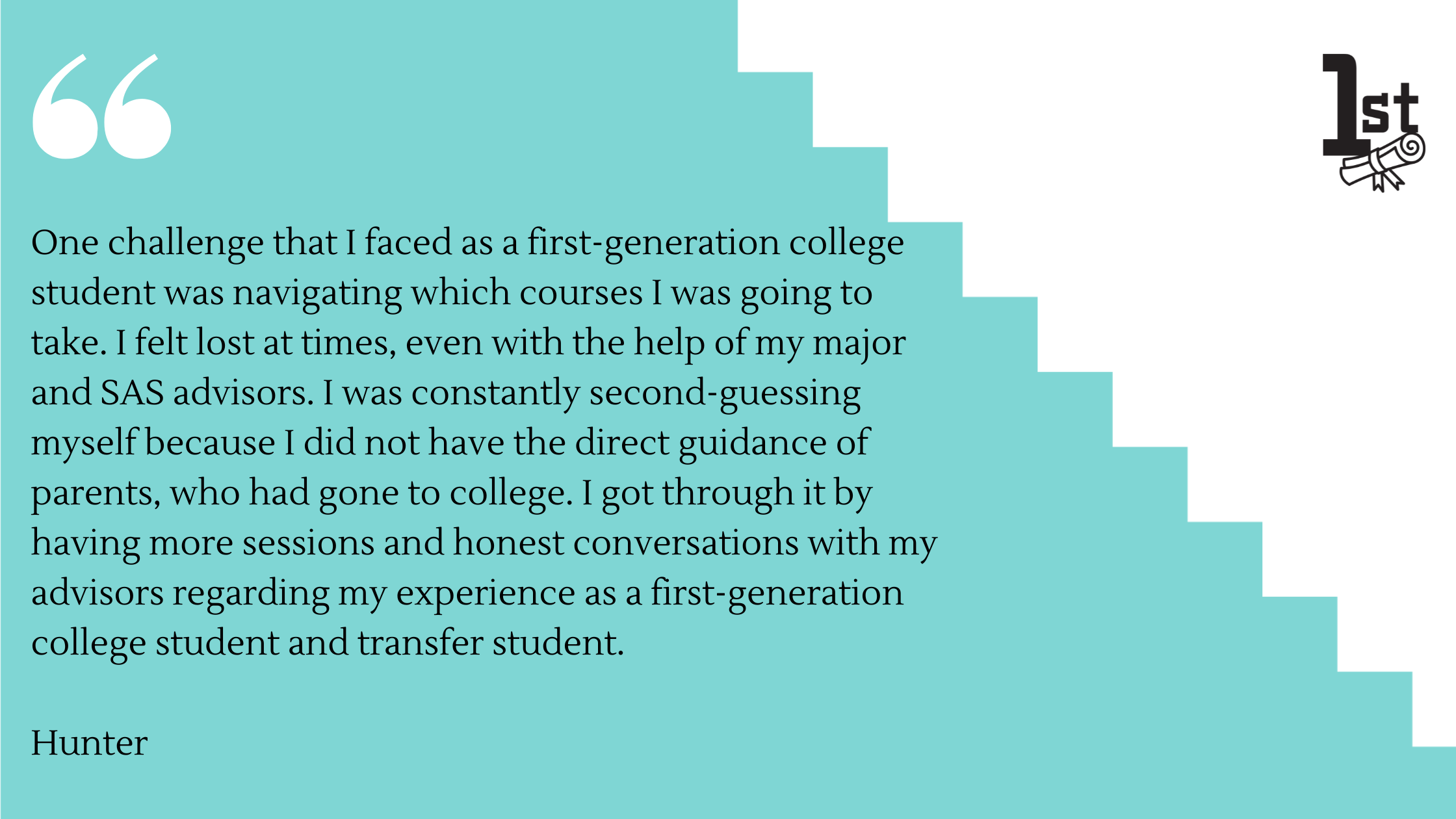
In conversations within the Being First Collaborative, many members commented on how challenging it can be to navigate Rutgers. Even as seniors, they were still just learning about resources and opportunities. First-generation college students often depend on faculty, friends, and classmates to learn about resources and opportunities. As an instructor, you are well positioned to share resources with your learners that can help make college less confusing and isolating.
Strategies
-
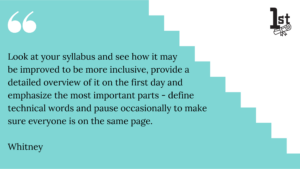
Why?
You may have heard of the “hidden curriculum”: the idea that some of the ways of college are implicit and known by some, but not all (Gable, 2021; Margolis, 2001). All of us contend with the hidden curriculum to some degree, but families with college experiences are better situated to support their loved ones when applying for college or navigating college once admitted. What’s more, because many instructors are not first-generation learners, and because it has been a long time since instructors have been undergraduate students themselves, it can be difficult to discern what is “insider” knowledge. Rather than place the burden of figuring things out entirely on learners, we can partner with them by learning more about the hidden curriculum ourselves and being careful not to assume that our learners will know what is expected.
One way we can counteract the hidden curriculum is by being intentionally explicit and transparent in our teaching. Transparency helps all students, but it is particularly beneficial for first-generation students: “Researchers from the TILT [Transparency In Learning and Teaching] project found that in courses where students perceived assignments as more transparently designed, gains were realized in three areas that are important predictors of success: academic confidence, sense of belonging, and mastery of skills that employers value most when hiring. Those benefits were larger for first-generation and low-income students, as well as for students historically underrepresented in college” (Artze-Vega et al., 2023, pg. 36). When designing assignments and creating instructions for students, it’s beneficial to be as transparent as possible. Include elements such as how the assignment aligns to the course learning goals and what the criteria for success are. Often, sharing a rubric is the most effective way to do this (access the SAS Rubrics resource on Canvas).
How?
- Learn more about the “hidden curriculum” and ways you can mitigate its negative effects. When relevant, share the concept of the “hidden curriculum” with your learners to provide language for an experience they may be having, but may not fully make sense of; doing so may help them navigate their college experience.
- Be intentional about learning what students might not know about college. For example, the Being First Collaborative pulled together this list of terms that they were unfamiliar with as students: List of Things to Demystify. You can address these topics directly if you bring them up in class; you can also share a link on your syllabus or in your Canvas course to this list of terms and Rutgers lingo, which is helpful to all learners new to Rutgers.
- Implement transparent teaching strategies into your course. In other words, be clear about what you expect students to do and know. Start small: begin by adding transparent elements to one assignment. For example, you could connect the assignments’ learning goals with the course learning goals or include criteria for success, such as a rubric, before learners complete the assignment. Look over your major assessments and exams for transparency. Are they closely aligned with the course learning goals? Are learners able to demonstrate their knowledge effectively? The TILT project website has many resources to help you build transparency into all aspects of your course.
- Communicate your grading policies clearly to students in your syllabus, and multiple times during the first few weeks of class and throughout the course, as relevant (Nunn, 2018).
- Reflect critically on your own experience of academic success. What background knowledge or circumstances helped you get to where you are today? Who helped you along the way? What do you remember being confused about as an undergraduate student? Then, find opportunities to directly and explicitly discuss those topics with your students. Perhaps during office hours, or in informal conversations before or after class.
References
Artze-Vega, I., Darby, F., Dewsbury, B., & Imad, M. (2023). The Norton guide to equity-minded teaching. W.W. Norton and Company.
Gable, R. (2021). The hidden curriculum : First generation students at legacy universities. Princeton University Press. 10.1515/9780691201085
Margolis, E. (2001). The hidden curriculum in higher education. Psychology Press.
Nunn, L. M. (2018). 33 simple strategies for faculty : A week-by-week resource for teaching first-year and first-generation students. Rutgers University Press. 10.36019/9780813599519
-
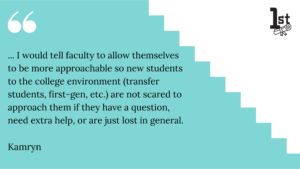
Why?
First-generation students often don’t view faculty as facilitators of their learning; instead, they often feel like they have to put their head down and get work done (Jack, 2016). First-generation learners face barriers to attending office hours even if they are seeking help (Yee, 2016). This happens when learners feel uncomfortable taking up the instructor’s time, or don’t know if office hours are the right venue for their concerns. Another barrier is that the term ‘office hours’ is not clear. Some students interpret ‘office hours’ to be time that an instructor is busy in their office.
NOTE: start at 3:30 to get to the office hours topic
How?
- Consider changing the name to Student Support Hours, or Student Drop-in Hours to more clearly convey the nature of the interaction.
- Demystify office hours in your syllabus. Explain what they are: an opportunity to ask questions about the course, get help with the material, connect with the instructor, discuss issues and concerns, or get advice on academic or career trajectories. Also explain in a welcoming way how they work. You might, for instance, say you can drop by my office during these times and we can chat informally about whatever is on your mind; or you could tell students please bring a question or topic that you want to discuss with me; or you could say I will start the session by asking questions.
- Remind students about upcoming office hours in class or through Canvas announcements, especially when difficult topics or major assignments may make office hours particularly helpful. Be sure to explain how students can schedule a meeting if they cannot make the scheduled office hours and how they can arrange an online meeting if that is necessary.
- If it’s feasible for the size of your course, consider brief mandatory office hour visits early in the semester to break down the barrier, get to know each student, explain what office hours are, and demystify the whole experience. Offer these in small groups for 15 minutes each. Offering these meetings virtually can also enhance accessibility and efficiency.
References
Jack, A. A. (2019). The privileged poor : How elite colleges are failing disadvantaged students. Harvard University Press. 10.4159/9780674239647
Yee, A. (2016). The unwritten rules of engagement: Social class differences in undergraduates’ academic strategies. The Journal of Higher Education (Columbus), 87(6), 831–858. 10.1353/jhe.2016.0031
-
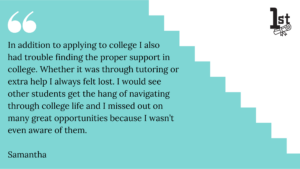
Why?
Although mentoring has a positive impact on first-generation learners’ sense of belonging (Soria, et al., 2024) and success (Reid & Moore, 2008), first-generation learners experience more barriers to accessing mentorships (Stebleton & Soria, 2012). Recognizing that there are often constraints that make it unworkable to provide each student with a mentor, one way to ensure that all students in your classes have access to some of the benefits of mentorship is to mentor “at scale.”
Members of the Being First Collaborative valued and desired the sort of informal mentorship and advice that naturally develops in one-to-one interactions with our students. However, given the constraints of larger class sizes, it’s often infeasible for these relationships to emerge for all students. Research indicates that in such circumstances, historically underrepresented learners, which make up a significant portion of first-generation learners, get lower access to mentorships (Scherer, 2020).
How?
- Share relevant academic resources that support the cultural capital needed for academic success, like library training resources (Charles, 2023), writing support, learning centers, etc.
- Structure accessing academic support services into your course by asking a librarian to do a workshop during a class session, requiring the use of academic resources as part of the assignment, or simply assigning accessing these resources as a graded assignment.
- Build into your regular lessons small updates about what learners should be thinking about at different stages of their academic careers and what opportunities exist for experiential learning. For example, mention when students should be thinking about applying for internships or graduate school.
- Be familiar with and share opportunities specific to first-generation learners, such as The THRIVE Student Support Services, and the McNair Scholarship Program. Did you know there is funding for first-generation learners who took a global themed Byrne first-year seminar to study abroad? See the Rutgers Global scholarships page for more detailed information.
- Explain how your course, field, or discipline may be relevant to students’ career aspirations; where possible, create authentic assignments, assessments that incorporate career or real-world skills and connections. If you want to learn more about connecting your mentoring to career competencies, refer to NACE Career Competencies.
- Make explicit the types of transferable skills gained from your discipline or course; discuss the range of job possibilities for learners in your department or discipline (Opsal et al., 2023). Suggest that students access the New Brunswick Career Exploration and Success resources. Let students know about the Career Explorations in Arts and Sciences 1.5 credit mini-courses.
References
Charles, L. H. (2023). Insights on first-generation students’ development of social capital for the rigours of college-level research. Journal of Information Literacy, 17(2), 85–107. 10.11645/17.2.9
Opsal, T., Windsong, E. A., & Pedroni, L. (2023). From here to there: Using required courses to expand first-generation mentorship accessibility. Teaching Sociology, 51(3), 218–230. 10.1177/0092055X231174513
Reid, M. J., & Moore, J. L. (2008). College readiness and academic preparation for postsecondary education: Oral histories of first-generation urban college students. Urban Education (Beverly Hills, Calif.), 43(2), 240–261. 10.1177/0042085907312346
Scherer, M. L. (2021). Unequally adrift: How social class and college context shape students’ mentorship experiences (vol 35, pg 744, 2020). Sociological Forum (Randolph, N.J.), 36(3), 856–857. 10.1111/socf.12722
Soria, K. M., Krueger, K., Kokenge, E., Aguilera-Gonzalez, D., & Natividad de Frausto, M. (2024). Academic and student affairs professionals as mentors: Benefits for working-class first-generation students. Journal of Student Affairs Research and Practice, 61(1), 1–15. 10.1080/19496591.2022.2147012
Stebleton, M. J., & Soria, K. M. (2012). Breaking down barriers: Academic obstacles of first-generation students at research universities. The Learning Assistance Review, 17(2), 7.
-
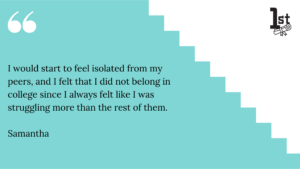
Why?
Students are excellent resources for each other, but there are surprisingly few opportunities for students to meet each other during classes, especially larger classes. First-generation learners experience barriers to reaching out for support (Yee, 2016), so increasing connection between learners can increase access to resources. Further, when we don’t understand something, it can feel like everyone else knows what’s going on while we don’t. When we use peer learning or interactive learning techniques, students often realize that others are experiencing similar challenges with course material. This can be helpful for learners because it normalizes struggle, which may mitigate a threat to a sense of belonging (more on this in the next section).
Students arrive differently prepared and come from a variety of backgrounds. First-generation learners are more likely to be coming from lower resourced educational backgrounds (Salehi, et al., 2020). On the other hand, first-generation learners arrive with life experiences and prior knowledge that enable them to better grasp some course concepts (Castillo-Montoya, 2017). There is ample opportunity for all students to learn from each other, both in terms of the course content at hand and the range of perspectives and insight their backgrounds provide. And, more broadly, students can be great resources for each other as they navigate college.
Finally, college can be isolating for those who come from cultural backgrounds that do not match the culture of higher education, which often values competition and individuality (Canning, et al., 2020; Stephens, et al., 2012). Incorporating elements of collaborative or cooperative learning is inclusive in that these approaches align with cultures that value interdependence, and draw on different sets of strengths (Delima, 2019; Yasso, 2005). Estefan, et al. (2023) argue that we can interrupt systemic inequities in higher education, at least in part, via the classroom by incorporating equitable practices that deliberately connect learners interdependently, build on prior knowledge, and proactively engage learners.
How?
- Carve time out in the beginning of the semester to allow learners to introduce themselves to a few people sitting near them. Simple introductions, like name, areas of academic interest, year, and why they are taking the class are sufficient. If you want to take this a step further, you can invite learners to show a partner or two a recent picture on their phone that represents some aspect of themselves. Self-introductions can also be set up online on Canvas as a discussion.
- One of the easiest strategies that can be used to encourage learning from each other in any class, no matter how large, is the simple ‘turn to your partner’ or ‘think-pair-share’. This strategy is easy to implement, and creates an atmosphere of collaboration that enhances all learners’ experiences. Here’s how:
At the beginning of a class, you can ask learners to turn to a partner:
-
-
- to discuss what they already know about a topic, and what questions they have.
- to summarize the articles they read for homework and point out any areas of confusion.
-
At any point in a class, you can ask learners to turn to a partner:
-
-
- to pause and summarize what the main point of the class was so far.
- to break and quiz each other on the syllabus you just went over.
- to solve a problem together.
- to identify a main question they still have.
- to identify a personal experience that relates to the course concepts.
-
At the end of a class, you can ask learners to turn to a partner:
-
-
- To identify the most confusing aspect of the class.
- To identify the top takeaways of the lesson.
- To come up with one or two questions they still have.
-
And the list goes on. These smaller low-stakes conversations provide space for all learners to share their unique experiences and perspectives without putting them on the spot.
You can wrap up the discussion by asking one or two groups to summarize their conversation for the whole class, or you can ask them to share their thoughts briefly and anonymously with an online poll.
Still looking for more? Check out Harvard’s Project Zero Think-pair-share and Kent State University Think-pair-share. Another example of having learners share with a partner is what Eric Mazur calls Peer Learning. See a video of this strategy in action.
- Consider other ways to incorporate interdependent group work. Refer to this resource from the Rutgers Institute for Teaching, Innovation, & Inclusive Pedagogy (TIIP) for optimal outcomes with group work: Effective Teaming Resource (you will be prompted to log in with your Rutgers credentials).
- If you want to incorporate more active learning into your courses, or happen to teach in an active learning classroom, the Rutgers Active Learning Community has teaching tools available on their website to support your efforts.
References
Canning, E. A., LaCosse, J., Kroeper, K. M., & Murphy, M. C. (2020). Feeling like an imposter: The effect of perceived classroom competition on the daily psychological experiences of first-generation college students. Social Psychological & Personality Science, 11(5), 647–657. 10.1177/1948550619882032
Castillo-Montoya, M. (2017). Deepening understanding of prior knowledge: What diverse first-generation college students in the U.S. can teach us. Teaching in Higher Education, 22(5), 587–603. 10.1080/13562517.2016.1273208
Delima, D. G. (2019). Making a case for a funds of knowledge approach to teaching and learning for first-generation college students. College Teaching, 67(4), 205–209. 10.1080/87567555.2019.1630355
Estefan, M., Selbin, J. C., & Macdonald, S. (2023). From inclusive to equitable pedagogy: How to design course assignments and learning activities that address structural inequalities. Teaching Sociology, 51(3), 262–274. 10.1177/0092055X231174515
Salehi, S., Cotner, S., & Ballen, C. J. (2020). Variation in incoming academic preparation: Consequences for minority and first-generation students. Frontiers in Education, 510.3389/feduc.2020.552364
Stephens, N. M., Fryberg, S. A., Markus, H. R., Johnson, C. S., & Covarrubias, R. (2012). Unseen disadvantage: How american universities’ focus on independence undermines the academic performance of first-generation college students. Journal of Personality and Social Psychology, 102(6), 1178–1197. 10.1037/a0027143
Yee, A. (2016). The unwritten rules of engagement: Social class differences in undergraduates’ academic strategies. The Journal of Higher Education (Columbus), 87(6), 831–858. 10.1353/jhe.2016.0031
Yosso, T. J. (2005). Whose culture has capital? A critical race theory discussion of community cultural wealth. Race, Ethnicity and Education, 8(1), 69–91. 10.1080/1361332052000341006